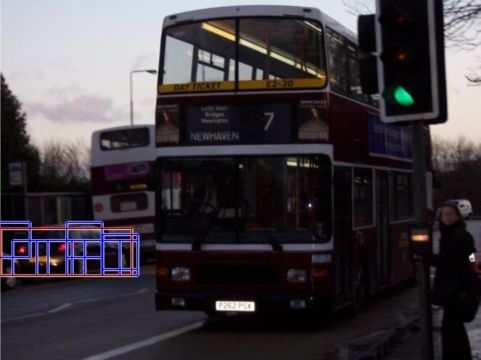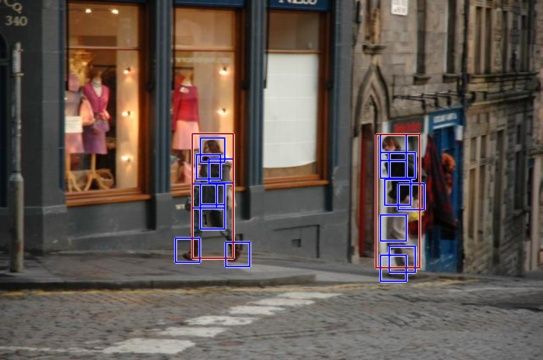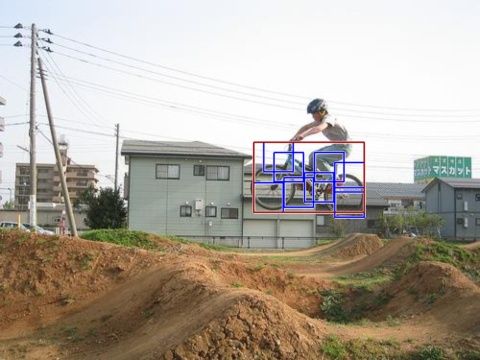可变形部件模型DPM和HOG特征for行人检测Discriminatively trained deformable part models
Discriminatively trained deformable part models
Version 5 (Sept. 5, 2012)
Introduction
Over the past few years we have developed a complete learning-based system for detecting and localizing objects in images. Our system represents objects using mixtures of deformable part models. These models are trained using a discriminative method that only requires bounding boxes for the objects in an image. The approach leads to efficient object detectors that achieve state of the art results on the PASCAL and INRIA person datasets.
At a high level our system can be characterized by the combination of
- Strong low-level features based on histograms of oriented gradients (HOG)
- Efficient matching algorithms for deformable part-based models (pictorial structures)
- Discriminative learning with latent variables (latent SVM)
This work was awarded the PASCAL VOC "Lifetime Achievement" Prize in 2010.
Code
Here you can download a complete implementation of our system. The current implementation extends the system in [2] as described in [6]. The models in this implementation are structured using the grammar formalism presented in [4]. Previous releases are available below.
The distribution contains object detection and model learning code, as well as models trained on the PASCAL and INRIA Person datasets.
This release also includes code for
- Rescoring detections based on contextual information
- The fast cascade detection algorithm described in [3]
- Training the person detection grammar described in [5]
The system is implemented in MATLAB, with helper functions written in C/C++ for efficiency reasons. The software was tested on several versions of Linux and Mac OS X using MATLAB version R2011a. Earlier versions of MATLAB should also work, though there may be compatibility issues with releases prior to 2009.
For questions regarding the source code please read the FAQ first. Contact Ross Girshick at [email protected] (click the "..." to reveal the email address) if you're still stuck.
Source code and model download: voc-release5.tgz (updated Sept. 5, 2012).
New: I also maintain a repository on github that includes bug fixes, speed improvements, and other updates. In general that code will produce different (though similar) results to the tables listed below.
What's changed since voc-release4? changelog
This project has been supported by the National Science Foundation under Grant No. 0534820, 0746569 and 0811340.
How to cite
When citing our system, please cite reference [2] and the website for this specific release. Bibtex entries are provided below for your convenience.
@misc{voc-release5,
author = "Girshick, R. B. and Felzenszwalb, P. F. and McAllester, D.",
title = "Discriminatively Trained Deformable Part Models, Release 5",
howpublished = "http://people.cs.uchicago.edu/~rbg/latent-release5/"}
@article{lsvm-pami,
title = "Object Detection with Discriminatively Trained Part Based Models",
author = "Felzenszwalb, P. F. and Girshick, R. B. and McAllester, D. and Ramanan, D.",
journal = "IEEE Transactions on Pattern Analysis and Machine Intelligence",
year = "2010", volume = "32", number = "9", pages = "1627--1645"}
References
- P. Felzenszwalb, D. McAllester, D. Ramanan
A Discriminatively Trained, Multiscale, Deformable Part Model
IEEE Conference on Computer Vision and Pattern Recognition (CVPR), 2008
- P. Felzenszwalb, R. Girshick, D. McAllester, D. Ramanan
Object Detection with Discriminatively Trained Part Based Models
IEEE Transactions on Pattern Analysis and Machine Intelligence, Vol. 32, No. 9, Sep. 2010
pdf - P. Felzenszwalb, R. Girshick, D. McAllester
Cascade Object Detection with Deformable Part Models
IEEE Conference on Computer Vision and Pattern Recognition (CVPR), 2010
pdf - P. Felzenszwalb, D. McAllester
Object Detection Grammars
University of Chicago, Computer Science TR-2010-02, February 2010
pdf
- R. Girshick, P. Felzenszwalb, D. McAllester
Object Detection with Grammar Models
Neural Information Processing Systems (NIPS), 2011
pdf
- R. Girshick
From Rigid Templates to Grammars: Object Detection with Structured Models
Ph.D. dissertation, The University of Chicago, Apr. 2012
pdf slides
Example detections
Detection results — PASCAL datasets
The models included with the source code were trained on the train+val dataset from each year and evaluated on the corresponding test dataset.
This is exactly the protocol of the "comp3" competition. Below are the average precision scores we obtain in each category.
| aero | bicycle | bird | boat | bottle | bus | car | cat | chair | cow | table | dog | horse | mbike | person | plant | sheep | sofa | train | tv | mean | |
|---|---|---|---|---|---|---|---|---|---|---|---|---|---|---|---|---|---|---|---|---|---|
| without context | 45.6 | 49.0 | 11.0 | 11.6 | 27.2 | 50.5 | 43.1 | 23.6 | 17.2 | 23.2 | 10.7 | 20.5 | 42.5 | 44.5 | 41.3 | 8.7 | 29.0 | 18.7 | 40.0 | 34.5 | 29.6 |
| with context | 48.2 | 52.2 | 14.8 | 13.8 | 28.7 | 53.2 | 44.9 | 26.0 | 18.4 | 24.4 | 13.7 | 23.1 | 45.8 | 50.5 | 43.7 | 9.8 | 31.1 | 21.5 | 44.4 | 35.7 | 32.2 |
| with context & extra octave |
49.2 | 53.8 | 13.1 | 15.3 | 35.5 | 53.4 | 49.7 | 27.0 | 17.2 | 28.8 | 14.7 | 17.8 | 46.4 | 51.2 | 47.7 | 10.8 | 34.2 | 20.7 | 43.8 | 38.3 | 33.4 |
| person detection grammar |
49.9 |
| aero | bicycle | bird | boat | bottle | bus | car | cat | chair | cow | table | dog | horse | mbike | person | plant | sheep | sofa | train | tv | mean | |
|---|---|---|---|---|---|---|---|---|---|---|---|---|---|---|---|---|---|---|---|---|---|
| without context | 33.2 | 60.3 | 10.2 | 16.1 | 27.3 | 54.3 | 58.2 | 23.0 | 20.0 | 24.1 | 26.7 | 12.7 | 58.1 | 48.2 | 43.2 | 12.0 | 21.1 | 36.1 | 46.0 | 43.5 | 33.7 |
| with context | 36.6 | 62.2 | 12.1 | 17.6 | 28.7 | 54.6 | 60.4 | 25.5 | 21.1 | 25.6 | 26.6 | 14.6 | 60.9 | 50.7 | 44.7 | 14.3 | 21.5 | 38.2 | 49.3 | 43.6 | 35.4 |
| person detection grammar |
48.7 |
Detection Results — INRIA Person
We also trained and tested a model on the INRIA Person dataset.
We scored the model using the PASCAL evaluation methodology in the complete test dataset, including images without people.
Annotations for the INRIA dataset in the PASCAL VOC format are available:
INRIA person training README INRIA person annotations
INRIA Person average precision: 88.0
Plot of Recall / False positives per image (FPPI)
Previous Releases
voc-release4
voc-release3
voc-release2
voc-release1
Back to rbg's homepage
from: http://www.cs.berkeley.edu/~rbg/latent/index.html



